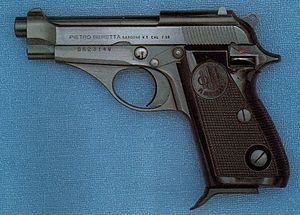Beretta 70
| Beretta 70 Series | |
|---|---|

The Beretta 70 in .32 ACP (7.65mm Browning)
|
|
| Type | Semi-automatic pistol |
| Place of origin | Italy |
| Production history | |
| Manufacturer | Beretta |
| Produced | 1958-1985 |
| Specifications | |
| Weight |
|
| Length |
|
| Barrel length |
|
| Height |
|
|
|
|
| Cartridge | .32 ACP, .380 ACP, or .22 LR |
| Action | Single Action |
| Feed system | 7, 8, 9, or 10 round detachable magazine |
| Sights | Fixed or Adjustable |
The Beretta 70 was a semi-automatic pistol series designed and produced by Beretta of Italy, which was based on the earlier 7.65mm Beretta M1935 pistol. Some pistols in this series were also marketed as the Falcon, New Puma, New Sable, Jaguar, and Cougar (not to be confused with the later Beretta 8000, which was also marketed as Cougar). The gun is notable for its appearances in film, and is also the first compact Beretta pistol to feature several improvements commonly found in Beretta pistols for the rest of the century.
The 70 Series improved upon the M1934/M1935 (and the later .22 LR offering of the same as the Model 948) in several ways. The swivel-lever safety of the M1934/35 was too difficult to operate one handed, so the 70 Series started out with the same cross-bolt safety as the M1951, but this safety was also difficult to operate with a single hand, and could also accidentally be switched on or off depending on the user's grip. After only a few years, the cross bolt safety was replaced with the thumb-activated, frame-mounted lever safety found on most Beretta pistols in the latter half of the 20th century, and indeed most single-action or traditional double-action semi-automatic pistols in production today, until the relocation of the safety to the slide with the Model 92S in 1983.
As the replacement for the M1934/5 in Beretta's compact/medium pistol line, the Model 70 integrated the M1951's takedown lever, guide rod system, slide stop, and magazine release button in the lower part of the grip. The M1934/5 would hold open on empty due to the magazine follower blocking the slide, but removing the magazine would cause the slide to be released unless its safety was subsequently engaged (which would lock the gun open until switched back to Fire mode); this process was slow and cumbersome, which is why the slide stop improvement was implemented in the M1951 and later models of service pistols. The slide stop changed partway through the production run of the pistol from the same "pedal" style release as the M1951 to a round button at the end of the lever. A softer, longer curve that tapered up to the front of the gun was also added to make the trigger guard more sleek. Near the end of its production, the same thumb shelf of the 76W's left grip panel was added to the 70S.
...
Wikipedia
